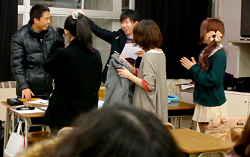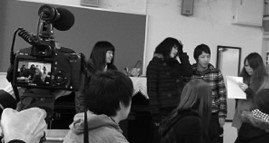Humanists rejected both the behaviorist notion that learning is a means to control and shape behavior [18] and the Freudian assumption that the subconscious drives learning [29]. Humanism argues that such perspectives view people as passive pawns and ignore the “profoundly holistic nature” of the human being [6, p. xvii]. This section reviews the humanist perspective on learning, summarizing key theories that laid the foundation for humanist education.
Abraham Maslow, Carl Rogers, and Rollo May were the intellectual leaders of the humanist psychology movement. Maslow [6] proposed that human motivations dynamically adjust and interact in a holistic hierarchy of dominance as individuals grow toward self-actualization and beyond to self-transformation. Rogers [30] proposed a learner-center approach to development, which applied his observations that psychotherapy facilitates significant learning. Rollo May introduced an existentialist element to humanism by emphasizing the developmental challenges of human existence [31].
Assumptions
Humanism recognizes the cognitive and behavioral processes that influence learning. But goes beyond mechanistic perspectives to identify the roles that motivation, choice, responsibility, and values play in development. They view learning as an act to explore the “higher levels of human nature” [7, p. 5].
A basic assumption of humanism is that motivation to learn and grow is inherent in human nature. Through learning, individuals make their lives better, develop self-control, and progress toward and transcend “full humanness” [7, p. 5]. With learning being an individual act to reach potential, the purpose of learning becomes growth toward maturity, autonomy [4], and self-transcendence [6, 32].
The role of the behaviorist or cognitivist instructor may be as an authority that controls and molds behavior. In comparison, the humanist instructor facilitates the development of the individual toward potential [4].
Maslow: Transcending “full humanness.”
Maslow [7] proposed that motivation to learn is inherent in human nature, that the desire to grow is universal. Unfortunately, Maslow observed, most individuals chose to not grow simply because growth is hard. From Maslow’s perspective, the goal of learning is to achieve self-actualization, to realize inherent potential. Contrary to the false interpretations of Maslow’s ideas as a rigid pyramid [33], human motivations dynamically adjust and interact in a hierarchy of relative prepotency. Individuals grow toward and transcend self-actualization [6]. Human learning dynamically serves to meet self-interest and to perform a greater purpose than self [32].
Rogers: Learner-centered education
Carl Rogers proposed that “significant learning is facilitated in psychotherapy” [30, p. 280]. He saw the purpose of learning as more than just accumulating knowledge and changing behavior. Learning is also a means to change life direction and modify personality.
Rogers proposed a learner-centered approach to education that viewed the elements of learning to be personal involvement, self-initiation, self-evaluation, pervasiveness, and integrated experience. From this perspective, educators help individuals develop personal strategies for growth by addressing current realities possibilities rather than dwelling on the past.
This “Client-Centered Therapy” [30, p. 246] approach to learning holds that humans have intrinsic tendencies toward self-actualization. Still, individuals must take responsibility for their own growth. An educator can help a person work toward potential by offering congruence, unconditional positive regard, empathetic understanding, and the ability to communicate these tendencies to the learner.
Applying client-centered therapy to education, Rogers proposed student-centered learning. This approach held that learning characteristics are personal involvement, self-initiation, learner evaluated, and experience-based.
May: Existentialism
Rollo May introduced to humanism an existentialist element, which emphasized the challenges of human existence. May emphasized that the price of free will is anxiety and despair, that people can choose to make the best of life, but that they can never escape the harsh realities of life (Wade & Tavris, 2008).
Existentialism identified the essential psychological resources as evil, suffering, creativity, art, and mythology (AHP, 2001). He proposed that identity and phenomenology are fundamental to human experience.
Maslow [7] said that Western researchers, like Rogers, Goldstein, and Erikson were more precise and correct in their exploration of identity but saw possibilities in integrating existentialist perspectives with humanism. With phenomenology, existentialism “uses personal, subjective experience as the foundation upon which abstract knowledge is built” [7, p. 9]. Phenomenology provides a framework for understanding how people make sense of their experiences. Maslow said that phenomenology could teach “us that the best way of understanding another human being… is to… see his world through his eyes” [7, p. 14].
Existentialism balanced the humanist perspective of the god-like potential of humans against the existential view of the creaturely nature of the human. In other words, humanism could now adapt the dichotomous perspective of human nature that religion had seen for millennia. The human is inherently creaturely and god-like being, yin and yang, good and evil.
Understanding “god-like human being” provided the humanists with a view of an ideal potential for an individual that transcends both self and culture. Existentialism condemned “the shallow and superficial life” through which people live by illusion and fear. Focusing on authentic and authentic living could help expand psychology and establish another branch that focused on the “fully evolved and authentic Self and its ways of being” (p. 16).
Applications
The collective vision of Maslow, Rogers, and May laid a foundation for the field of adult education by influencing the theories of andragogy and self-directed learning [1, 4].
Andragogy.
Androgy is a “concept and philosophy” introduced by Knowles that focuses on adults as learners [1, p. 231]. Defining an adult as an individual who takes responsibility for self and who fills the roles society typically associated with adults, Knowles [33] argued that adults are simply different from children and proposed that adult education should be differentiated from child education. Andragogy proposed a set of assumptions to serve as a model for designing adult education programs. Defined as “the art and science of helping adults learn,” andragogy became the antithesis to “pedagogy,” the science of teaching children.
Self-Directed Learning.
Self-directed learning is a process by which people manage their own learning by planning, executing, and evaluating alone or with a guide. The self-directed learner thrives in a purely andragogical environment. The self-director learner works independently on projects, engages with other learners, and discovers learning. Faculty fills the role as delegator for the self-directed learner, providing consultation at the learner’s request and monitoring the learner’s progress.
Intrinsic motivation plays a critical role in SDL by driving the learner to participate and supporting persistence to achieve goals. For example, the Fielding Graduate University model assumes students are entirely self-directed, providing limited structure or support from University or faculty. SDL competencies are situational, with four variables influencing whether a learner can act autonomously: technical skills, familiarity with the subject, competence, and commitment [4, p. 123].





![Your brain can keep growing, adapting, and learning at any age, if you are willing to put in the effort [Image: Copilot]](/images/Images/best-years-for-adult-brain300.png)
